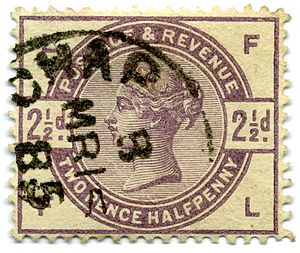Queen Victoria Lilac and Green Issue facts for kids
The Lilac and Green issue is a special set of postage stamps made in the United Kingdom in 1883 and 1884. They got their name because they were only printed in two colors: lilac and green. Lilac was used for stamps with values like 1½ pence, 2 pence, 2½ pence, and 3 pence. Dull green was used for stamps worth 4 pence, 5 pence, 6 pence, 9 pence, and 1 shilling.
These stamps were created because of a new law in 1881. This law said that postage stamps also needed to work as "revenue stamps." Revenue stamps were used to show that taxes or fees had been paid. So, these new stamps had "POSTAGE & REVENUE" written on them. Older stamps from 1880 only said "POSTAGE."
Contents
Why Lilac and Green?
The government chose these colors for a clever reason. They were worried that people were washing the ink off old stamps and using them again! To stop this, they wanted to use "fugitive inks." These are special inks that would wash away if the stamp was put in water. At that time, the only fugitive ink colors available were lilac and green. This made it harder for people to reuse stamps.
When Were They Released?
The first stamp in this series was the 9 pence stamp, released on August 1, 1883. It was needed quickly, so it came out before the others. The rest of the stamps, including the 1½ pence, 2 pence, 2½ pence, 3 pence, 4 pence, 5 pence, 6 pence, and 1 shilling values, were released later on April 1, 1884.
What Did They Look Like?
All the stamps in this series featured a picture of Queen Victoria's head. Her head was shown from the side, in what's called a "profile" view. The value of the stamp was written in the corners.
Some stamps were designed horizontally, meaning they were wider than they were tall. These included the 2 pence, 2½ pence, 6 pence, and 9 pence stamps. Other stamps were designed vertically, meaning they were taller than they were wide. These were the 1½ pence, 3 pence, 4 pence, 5 pence, and 1 shilling stamps.
Their Short Life
These dull-colored stamps were not very popular with the public. Because of this, a special group called the "Stamp Committee" was formed in 1884. Their job was to decide on better, more colorful stamps to replace them.
Just three years later, in 1887, the Lilac and Green stamps were replaced by a new series called the Jubilee Issue. The Jubilee stamps had many different designs and colors, which people liked much more.
Collecting These Stamps
Because the ink used on these stamps was "fugitive," many of the green stamps have lost their original color over time. This happened when people tried to carefully remove them from envelopes by soaking them in water. Stamps that still have their bright, original color are very special and are highly wanted by philatelists. A philatelist is someone who collects or studies stamps.


